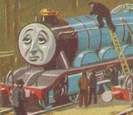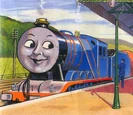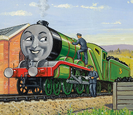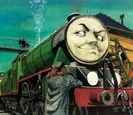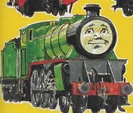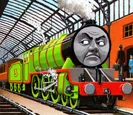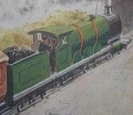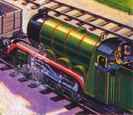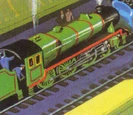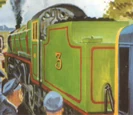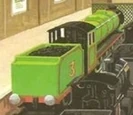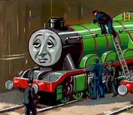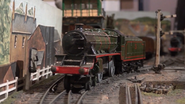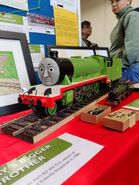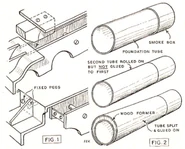
|
Background Information
The Railway Series
Henry is a fictional standard gauge tender locomotive created by the Rev. W. Awdry. He is the No. 3 engine on the North Western Railway.
He first appeared in The Railway Series book, The Three Railway Engines, which was published in 1945. His last appearance was in Thomas and his Friends, published in 2011.
Front of Henry:
The rear of Henry:
In the Railway Mischief DVD, the Mr. Perkins segment features a re-illustrated version of the story Thomas' Train where Henry is depicted in his television series livery to avoid confusing viewers who may not have read the original books.
Creation
In 1942, the Reverend Awdry told his son Christopher a bedtime story about an engine named Edward who was sad because he was never taken out of the shed for being old and the drivers choosing the bigger engines first. Awdry would then write a second story featuring one of the biggest engines whom he named Gordon. Awdry would then write a third story about an engine who was bigger than Edward, but smaller than Gordon, whom he named Henry. In the story, it is a rainy day, and Henry stops in a tunnel and refuses to move. His crew, the passengers, another engine and even the Fat Director try to get him to move, but to no avail. Eventually, they have him bricked up, and they bore a new tunnel.
Issues with Henry
In real-life
The Reverend W. Awdry had a great deal of trouble with Henry. Originally, Awdry had illustrated him as a 4-4-2 Atlantic, however, William Middleton changed this when he illustrated him as a 4-6-2 Pacific similar to Gordon. When Reginald Payne was asked to illustrate the second book, he drew Henry far too similar to Gordon with the rectangle buffers and all, making Henry’s only defining feature a copper chimney cap. Awdry was especially unhappy with C. Reginald Dalby's illustrations: he looked almost identical to Gordon, more so while he was painted blue. In Tank Engine Thomas Again, Henry looked completely identical to Gordon, but this was passed off by explaining he needed to use Gordon's buffers while his were being repaired. To make matters worse, he was illustrated inconsistently, often having several different shapes within the space of a single story. In most of Dalby's illustrations, Henry was portrayed incorrectly as a 4-6-0 instead of a 4-6-2.
Awdry's original idea had been to write Henry out of the series, but by "Henry the Green Engine" he had decided to instead have Henry involved in a serious accident, allowing him to be rebuilt into a Class 5MT. As this was a real locomotive, Dalby was thus forced to be consistent. Since then, Awdry would base all his locomotive characters on real-life prototypes and for such characters as Edward, Gordon, James and Percy, he would invent backstories for them.
In The Railway Series
According to The Island of Sodor: Its People, History and Railways (TIOS), Henry was an experimental locomotive built from plans stolen from Sir Nigel Gresley, but the wrong plans were taken and the locomotive built was so riddled with faults that the only person who could be persuaded to buy it was the Fat Controller, who, at the time, was desperate for any locomotive he could get.
There is a certain amount of argument over Henry's rebuild, caused by "TIOS", which was written to provide historical background to The Railway Series and to correct pictorial inconsistencies that had occurred in earlier volumes. The Reverend W. Awdry claimed that the pre-rebuild and post-rebuild Henry were actually two completely separate engines, although in The Railway Series, Henry seemed familiar with events that happened before the crash. Henry's memory could have simply survived the rebuild, but as both sources can be considered equally canonical, the question of whether there have been two Henrys or one will likely remain unanswered.
"TIOS" also featured a biography of the Fat Controller, which mentioned that he was apprenticed with Stanier at Swindon Works. It is possible that this was another piece of retcon added to explain how Henry was able to be rebuilt so easily - something that even the Reverend W. Awdry admitted was "a mystery".
In Sodor: Reading Between the Lines Henry was said to look very much like a Stanier 5MT, which suggests that he is not totally identical to one of these engines. It is not clear why Christopher Awdry should have felt the need to contradict his father, but it could simply be a combination of errors and publication deadlines.
Behind the Scenes
Awdry's model
For his model railway Awdry constructed Henry out of a second-hand Graham Farish Black 5.
Much like the fictional character, Awdry's Henry model was temperamental when it came to performance, and never ran properly. By the late 1950's, the motor had given out. Awdry was in the middle of fixing it when he became bedridden before his eventual death, and the model was lost for two decades before being found in 2019 in the Awdry Study exhibit at the Narrow Gauge Railway Museum at the Talyllyn Railway. It now sits in the Narrow Gauge Railway Museum in the condition in which it was discovered, as an example of a work in progress.[1]
P.R.Wickham's model
Edmund Ward had comissioned P.R. Wickham to produce models based on Engines 1-6 around the early 1950's, and were featured in an article titled "The Locomotive Family" featured in the March 1953 issue of Model Maker Magazine. These models were made in 7mm scale and were unpowered due to the lack of motors, although they did prove to be guides for the illustrators to work with, and the designs were based on C. Reginald Dalby's original illustrations.
1953 BBC Model
An OO scale model of Henry was created in 1953 for the BBC's adaptation of The Sad Story of Henry.
Meccano Ltd. (who manufactured the Hornby locomotives) supplied three OO scale Duchess of Atholl models and a tank engine which were first sent to the publisher's offices in Leicester to be "lightly modified" by P.R. Wickham in order to create the engines for the broadcast. He painted two of the engines to different colours and rebuilt two from Balsa wood, much to Meccano's surprise (they had only approved of faces being added). Wilbert Awdry said that the models are "similar if not almost identical to the illustrations".
References
- ↑ Rev Awdry's Forgotten Henry Model by The Narrow Gauge Railway Museum on YouTube


